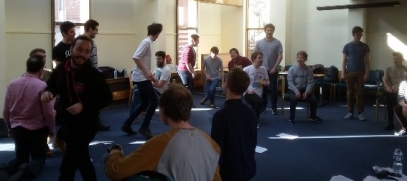Add a comment
Making Music the Mantunian Way
‹-- PreviousNext --› Action shot of Sitting-Standing-Kneeling
Action shot of Sitting-Standing-Kneeling
Last Sunday took me up to Manchester to work with Mantunian Way, the men’s chorus from the Manchester University Barbershop Society. They are preparing for the BABS Convention in Harrogate in May, and this was their last rehearsal before a three week break over Easter. It is a rehearsal rhythm driven by university term times, and it has some drawbacks in terms of loss of momentum, but it also offers some advantages. When you come back after a break, some things are forgotten, others have embedded themselves without you noticing and are suddenly fluent.
It is an intelligent chorus – university students are by definition people who are in the habit of absorbing and applying new ideas – and as I coached I had my eyes not just on their performance in two months time, but in the potential for this cohort to produce barbershop’s leaders of tomorrow. We dealt not just in what to do with particular moments of songs, but generalisable principles that can be applied to other repertoire in other circumstances.
I did a fair bit of work with their director, Matt Thomas, as the chorus were clearly very responsive to his conducting and thus we could make changes most efficiently by adapting his gestures. He has a great grounding in that he uses pattern fluently and clearly, so we could use this as the framework to develop clarity into artistry.
When you’re writing, some days you count progress in words written, some days in words deleted. When you’re working on conducting technique, sometimes the most useful thing to do is less of it. So we started by removing his non-dominant hand from its habit of continual mirroring, and just brought it out for special musical occasions. Mirroring is a tool that when used all the time loses meaning, but used sparingly, becomes salient.
We also used the nuclear option for feedback on mouthing the words: any time the chorus spotted him doing so, they were instructed to hit the mute button. It was fun seeing Matt playing with this feedback mechanism, and every so often start mouthing the words on purpose in order to start the chorus miming. Nice use of the Inner Game principle of Will.
Once other body parts are no longer competing for attention, the dominant hand can start exploiting the inherently expressive shapes of pattern to bring out musical ebb and flow.
All that gave Matt plenty to work on, so I turned my attention back to the chorus and worked with them on finding the meaning in the musical structures they were working with. The shapes of lines, voicing of chords, harmonic colours and textural choices could all be mined for their inner messages about the emotional shape of the songs.
A principle we worked with to good effect was motivating dynamic change. In several places, the lyric and/or musical shape had led them to make changes in volume – but what we were tending to hear was the intention to make a dynamic change rather than the reason why the dynamic change made musical sense. We focused on articulating the underlying narrative purpose of the change, and singing that rather than the performance instruction.
So, it wasn’t a diminuendo, it was increasing despair; it wasn’t a subito piano, it was quoting what the addressee of the song had said. This way we still got volume changes, but they were integrated into the narrative, and worked in tandem with colour and prosody to keep the meaning to the fore.
We spent a good deal of the afternoon playing with backbeat. You can tell you’ve found the right groove for a song when so many of its details come into focus without any deliberate attention. People just experience and respond to the musical shapes when you get the rhythmic framework in place.
Towards the end of the afternoon, the brains were getting towards the end of their useful capacity for the day, but we still had a little energy to play with, we ran their up-tempo tune within the improv game of Sitting-Standing-Kneeling. They had such fun with it! It’s a great way to make people work hard at the song without putting themselves under pressure, and the quality of teamwork required to play the game also does wonders for the overall ensemble.











